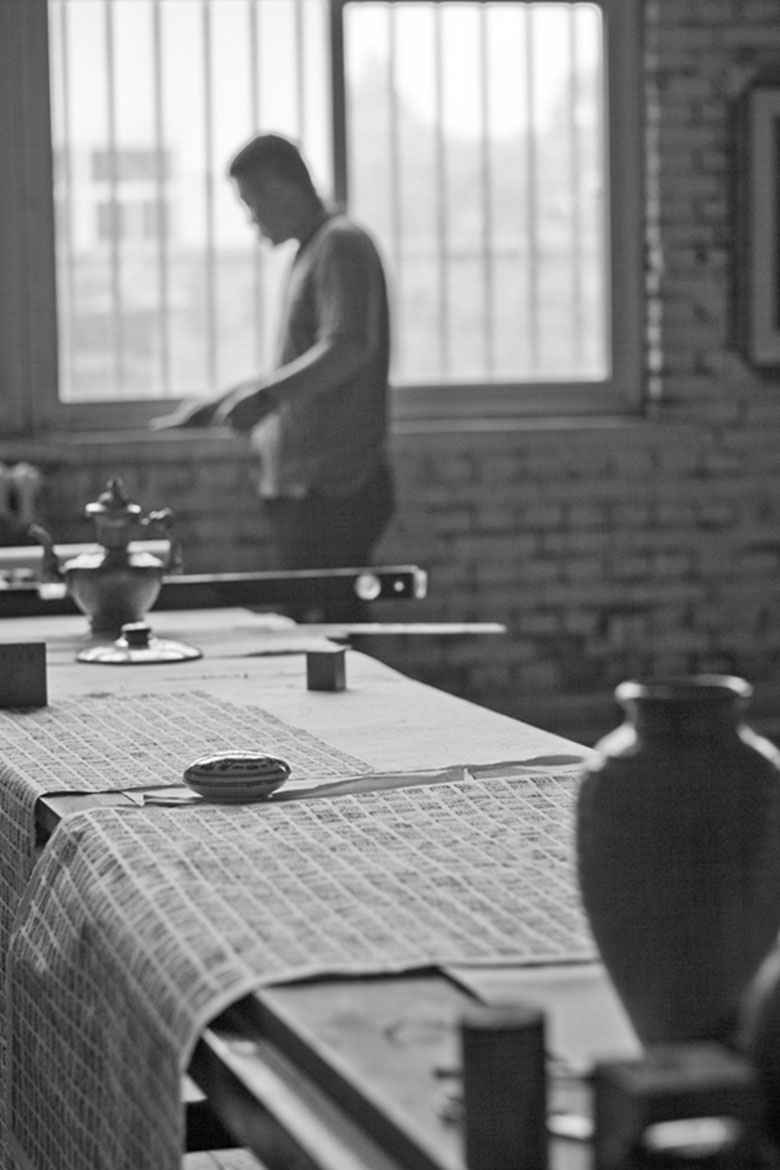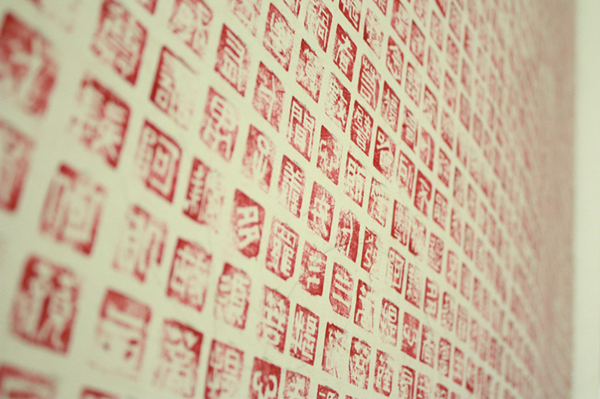 |
|
 |
|

《声音》
《说文》声“音”也,“音”声生于心,有节于外,谓之音。常用字典“音”有言辞之意。据《礼记·乐记》:“凡音者,生人心者也。故形于声,声成文谓之音”,也是“言辞”之意。英文中SOUND即可动词,也可为名词。我喜欢用“The Sounds”。
作品《声音》有似于看图识字的感觉。5169个青田石印、26米的长卷、百十幅拓片,内容是一部《金刚经》。想起小时候初学绘画时,姨姨拿来的范本是声讨“四人帮”的漫画集。识图看人,范本的言辞之意小时候深信不疑,“四人帮”真是罪大恶极。大学研习油画,一头雾水。“85”思潮轰轰烈烈,国外“先进”流派纷纷涌入,理论铺天盖地。本雅明(Walter Benjamin)所写的“游手好闲者”更散发出迷人的光芒。毕业后辞了工作来北京,成了一个“自由人”。
斗转星移,一晃已是十年。
20世纪西方前卫艺术的最主要特征——实验性,也成为当代中国的另一传统,而这一传统在中国则成了现代性的重申。
《声音》是《写与刻》的延续。《写与刻》创作于1995年,是由刻着文字的木版条块组成的大小装置作品。展出不多。“声音”和“写与刻”同是文字化的图示。“声音”的创作从2004年持续到2006年,为期两年避开外界的喧嚣,整个创作过程值得欣慰。创作不单单是刻写石头,拓印长卷,而是“文本和读者之间的视界融合”(加达默尔),一千五百年年前的那场持续长达两百年的佛经翻译运动渐渐呈现出图像,变成了一种声,而后在唐宋诗词中,在元曲、明清传奇的不同文本中获得释放。今天你需要用心真的去倾听,而这真的倾听或许就是那般若之所在、觉悟之开始。
“生而同声,长而异俗”皆因为后天教化不同所致,这是后天教化不同的结果。当代艺术如同其生长环境一样——迅猛且尴尬,“迅猛”地开出众多鲜艳的花朵,“尴尬”地在市场经济中变为一种功利主义的符号。“有无市场”成了作品好与坏的评判标准。但我喜欢ART和ARTIST在词源中所表达的非功利主义的“人文”趣味。
北京的十年,当代艺术如火如荼。所幸的是有了一个他自己起名叫“图图”的孩子,圈里的朋友说这孩子和当代艺术一起成长。看展览时他时常和我在一起。在一个朋友的画廊里,他翻着画册,指着一群光屁股男人问:“爸爸,怎么没有你?”看来我非光一次不可。(人们更爱看光屁股女人!)
北京在一天天地增高。用心良苦的人们在建立,创造着符号。向远望去,如同草丛中一簇簇狗尾巴草——倒是也好看。在众多的符号中,我更愿意看到那枝塔影,有诗为证:
无恙蒲帆新雨后
一枝塔影认北京1
1. 北京通州燃灯佛舍利塔

Following the Sounds...
The English title of my works is “The Sounds”, a literal translation of “Sheng Yin” in Chinese. I was told that “sound” in English can be either a verb or a noun. In Chinese, however, the two-character title is etymologically
more complex. To trace the origin of the characters, I would have to refer
you to the Shuowen Jiezi, the first comprehensive Chinese character
dictionary from the Han Dynasty, the first to analyze the components and etymology of the characters. It says “Sheng” means to “to hear with the
ear”, “yin” means “a mouth with something in it and a tongue sticking out
with something on it - speech”. The great master Confucius also pointed
out that “yin” comes from the heart and also takes the form of “sheng”, by which he too meant speech.
The exhibit is composed of 5,169 engraved stone seals, a 26-metre long
imprint scroll, and dozens of lithographic imprints, which feature in full
length or in part the text of “The Diamond Sutra”. I would tather compare
The Souds as a primary reader, just like the only textbook I had when I
was first introduced to painting at a tender age in the aftermath of the
Cultural Revolution. It was a comic book featuring the nation-wide
campaign denouncing the “Gang of Four”.That very little picture book
served its purpose well - I was utterly convinced that the “Gang of Four”
deserved all the condemnations.
When in 1985 I become a student of oil painting in the art department, I
was for some time perplexed with the bombardment of the western avant-garde art theories flooded into China especially in the wake of the
Chinese “1985 Art Movement”. The idea such as that of Walter Benjamin’s “being the flaneur, the aimless wanderer who loses himself in the city,
stands back from the crowd and whose urgent and single-minded
purpose is to have no urgency, lose his way and observe” sounded just
inviting. So after graduation, I quit my job and settled down in Beijing as a
freelancer.
It’s been a span of ten-odd years since I lived in this city.
The 20th century avant-garde art in the West was experimental. Being
experimental is an acquired liking of contemporary art in China, which in
turn, has become a vehicle for reiterating modernity.
The Sounds is a continuum of the earlier project “Calligraphy and
Carving”. Works of installation made up of wood tablets with carved calligraphy characters, whose motif coincides with that of the current work
although the preceding one was seldom on show. They both are graphic
renditions of Chinese characters.
I started to work on The Sounds early in 2004 and the project was
completed in mid-2006. The two year’ 8-to-6 daily routine in my rented
modest studio was a gratifying experience: it was a process of becoming
one with my creation and what it represents. In the end what can be seen
and heard in the exhibit is the two-century long unprecedented
endeavour of translating Buddhist sutras that began 1,500 years ago; the
same power and life can also be captured in the literary legacies of the
poetry of the Tang and Song dynasties, the prose of the Yuan dynasty
and the novels of the Ming an Qing dynasties. All one can do now is to
lend them our ears and hearts and listen attentively. Only by listening with
the heart and mind can one recapture the transce ndent wisdom that
endures the Diamond Sutra.
Things of a kind differ because the environments in which they are
nurtured differ. Art is no exception. Chinese contemporary art has so far
justly reflected its social scene, fast-growing with its inherent challenges.
On the one hand, the art scene has born fruits sometimes too soon; on
the other hand, art has been somehow reduced to a utilitarian status. To
some, ”marketable or not” seems to be the only criterion for judging art
works. Indeed,much has happened in the art world in Beijing.
To my great fortune, I became a father and my son grew up visiting
galleries and exhibitions with me whenever possible. Having frequentl
met him, quite a few friends in the circle often remarked that that boy
was a lucky observer to Beijing’s prosperous contemporary art. Once in
a gallery when he came across a photo of several naked man artists, the
boy stopped to ask me, “Baba, why were you not with them?” It seems
that I will have to go naked once to please my son’s curiosity. Don’t they
prefer to see nude women?
Beijing is constantly on the rise. People are working hard, setting up landmarks both literally and figuratively. The view of it all is like tufts of
bristle grass - quite pleasant to the eye. However, out of all the emerging
icons, what I crave for is the sight of a tower that is seen described in the
following verses of a poem:
The boat with cattail sails survived the harsh storm,
The sight of the towering skyline set us at ease
Because the tower is where Beijing - our home -is.
王皆
2006年12月
WANG Jie
December 2006